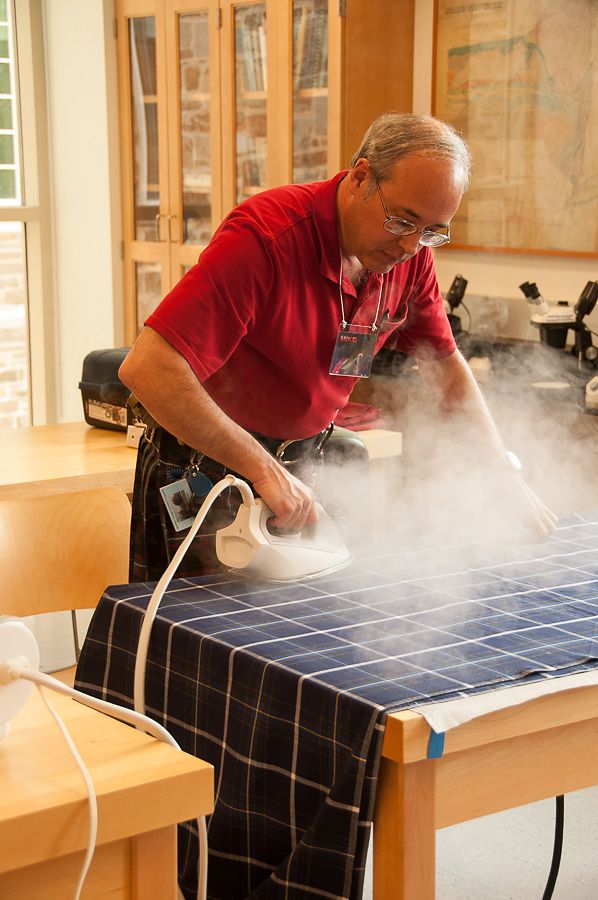|
-
Completely removing creases from wool
Im repositioning the apron in an old kilt by making it half an inch wider on each side so the centre stripe remains central. Does anyone know how to completly remove the creases of the old apron edge fully from the 16oz wool?
I've heard ironing on the wrong side using a dry cloth works best. Does anyone have ideas as I would like to remove the old crease line completely as is they never existed.
-
-
Dry ironing is not what you need. What you need is pressing with lots of steam. This allows the scales of the wool fibers to open up and relax the original crease. Then you need to cool the fabric quickly in the new (uncreased) configuration.
The best way to achieve this if you don't have a steaming system is to spray a press cloth (a clean white dish towel or pillow case) with water, lay it over the tartan, set your iron to wool setting with steam, and _press_ on top of the press cloth (don't iron back and forth). Let the steam and the pressure do the work. The press cloth not only provides adequate steam, but it also prevents shine from developing on the tartan. While the fabric is still hot, lift off the press cloth, and press down with a nice chunk of wood. This cools the fabric. A professional uses a tailor's clapper (http://www.wawak.com/TAILOR-CLAPPER?...FYwfhgodh1gM0w), but any chunk of raw wood will do provided that it isn't pitchy and doesn't have a finish.
I find that pressing from the crease side is more effective than pressing from the back side of the crease.
Last edited by Barb T; 7th July 16 at 10:01 AM.
-
The Following User Says 'Aye' to Barb T For This Useful Post:
-
When Barb is talking about a lot of steam this is what she is talking about.

This is our own Mike Suhar at Kilt Kamp 2013 taking creases out. His steaming system has a teflon soleplate to prevent shinies. He is also not pressing down at this stage but gently passing the steam over and through the fabric to heat up the fibers. This relaxes the fibers letting the creases sort of fall out.
Last edited by Steve Ashton; 7th July 16 at 09:08 AM.
-
The Following User Says 'Aye' to Steve Ashton For This Useful Post:
-
Here are a couple of fascinating SEMs comparing wool and polyester fibers:
http://www.gettyimages.com/detail/ph...mage/136811477 This one shows wool fibers, and you can see the little scales that open up when wool is heated and steamed.
Incidentally, wool "felts" because, when the wool is warm and wet and rubbed together, the little scales open up, catch on one another, and lock into place as a denser network (i.e., felt) when you cool the material. That's why your wool sweater shrinks 6 sizes when you accidentally run it through the washer...;-) Machine washable wool (like Smartwool) has had the fibers treated to basically lock down the scales so that felting can't happen.
This web site shows a wool-polyester blend, and you can easily see which fibers are wool (the scales!) and which are polyester (totally smooth!): http://www.gettyimages.com/detail/ph...aphy/128622924
-
The Following User Says 'Aye' to Barb T For This Useful Post:
-
Wow... thank you as always Barbara & Steve for your quick and informative replies. I'll give it go. I have a square of wood although its not heavy. It maybe worth investing in a clapper.
-
-
In my shop we use large, 2 inch wide x 36 inch long, thick aluminum rulers to suck the heat out of the wool. We make sure that the wool is good and hot. (Don't move or disturb the fabric when it is hot!) and then lay the ruler on the crease. The heat is literally sucked out of the fabric by the metal. Lift the rule and wave it around for a moment and repeat as necessary.
Clappers are great and I was taught that they were used, instead of, or in places you can't get a pressing iron. Actually clapping a seam down. (That's smacking the seam with a piece of wood, beating the fibers into submission, for those non sewing folks) If you have one, great, but any smooth piece of wood will work. Really smooth, no paint or varnish, and not a lot of sap like pine. Professional clappers are made from Maple or Ash.

And strangely enough I just did an image search to find this pic of a clapper. And what do you think I see in the list of images for "Tailors clapper"?
Guess who this is.

Last edited by Steve Ashton; 7th July 16 at 10:39 AM.
-
 Posting Permissions
Posting Permissions
- You may not post new threads
- You may not post replies
- You may not post attachments
- You may not edit your posts
-
Forum Rules
|
|



















Bookmarks